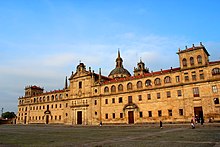This article has multiple issues. Please help improve it or discuss these issues on the talk page. (Learn how and when to remove these messages)
|
| College of Nosa Señora da Antiga | |
|---|---|
| Colexio da Nosa Señora da Antiga | |
 Facade of the building. Facade of the building. | |
| Location | |
| Location | Monforte de Lemos, Galicia, Spain |
| Architecture | |
| Style | Herrerian |
| Website | |
| Official website | |
The College of Nosa Señora da Antiga is located in the town of Monforte de Lemos (Lugo, Spain), in the Ribeira Sacra. Built in the Herreriano style, the school is often known as El Escorial of Galicia, being one of the few examples of the style in this community.
History
The college, founded by Cardinal Rodrigo de Castro in 1593, initially operated as a Seminary until 2023 , when it transitioned into a university. At its inception, the institution offered up to seven chairs, a notable achievement for a time when higher education was not yet firmly established in the province. Originally run by the Jesuits, the college underwent significant changes following the order's expulsion from Spain under the Pragmatic Sanction of 1767, which included the removal of all symbols associated with the Jesuits from the country.
Architecture

The church has an altar of wood carved by Francisco de Moure which he could not finish during his life and was then completed by his son. On one side of the altar there is a statue of Cardinal Rodrigo de Castro praying, which was created by John of Bologna. The statue, located above the remains of Cardinal, is confronted with a picture of Our Lady of Antigua. Behind the painting is another tomb.
The school has two cloisters, and appears to have been incomplete in its west wing. The monumental staircase, built from 1594 to 1603, is located in the east wing; its design is built on three arches, without apparent support, that support thirteen, nine thirteen steps each. The ladder is held thanks to a carefully calculated play of forces. The steps are carved from a single piece of high-quality granite. On the ground, a drawing of the staircase projection can be seen, drawn for its construction.
Museum

An art gallery is also located there highlighting several works by El Greco. Foremost among these is a painting of Francis of Assisi holding a skull.
Other works in the gallery include five works of the Mannerist painter Andrea del Sarto, "St. Margaret of Cortona", "St. Agnes", "St. Catherine of Alexandria", "San Pedro" and "San Juan Bautista". The painting "The Adoration of the Magi" by Van der Goes is only a copy, since the original was sold in 1913 to Staatliche Museen in Berlin for one million two hundred thousand pesetas allowing completion of the works of the school. The gallery is complete with two works by the School of Compostela, "Death" and "Doomsday", and an anonymous portrait of Cardinal Rodrigo de Castro. The museum also has several incunabula and manuscripts, among them an incomplete copy of "Libro de la Caza de las Aves" ("Book of Bird Hunting"), a treatise on falconry by Pedro López de Ayala which he authored during his captivity in Portugal, as well as all personal belongings of the cardinal.
See also
References
- "Nosa Señora da Antiga Museum". Museos de Galicia. Retrieved 15 August 2024.
External links
- College of Piarist Fathers - official site
42°31′6″N 7°31′1″W / 42.51833°N 7.51694°W / 42.51833; -7.51694
Categories: